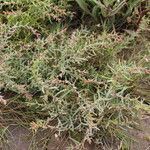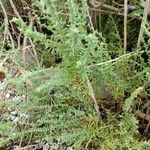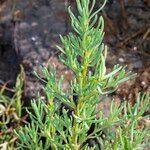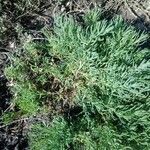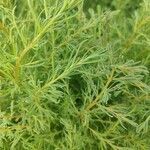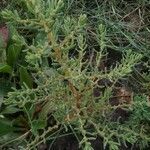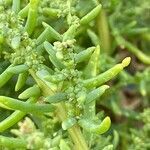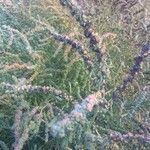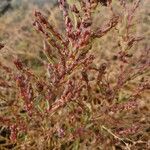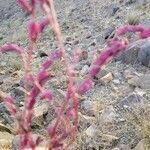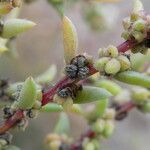Perennial glabrous herb, 7-45 cm long, at an advanced age often woody at the base, usually divided from the base into obliquely erect or ascending branches, often rooting from the lower joints; old stems tuberculate by scars of fallen leaves. Leaves rather crowded, linear, semiterete, with well-developed aquiferous tissue, glaucous or more or less tinged with purple or entirely purple, 1-4½ cm long, with a saltish taste. Inflorescence usually pan-iculately branched, 2½-15 cm; flowers in clusters of 2-5 or highest solitary, all ☿; lower bracts rather large, foliaceous; higher ones gradually smaller; bracteoles at the base of perianth 2-3, oblong obtuse, transparent, ⅔-1 mm long, persistent, after fall of the fruit ± stellately spreading. Perianth green of more or less suffused with purple; segments at first (female stage) conniving, leaving only at top a small orifice for the protrusion of the styles, afterwards (male stage) spreading, after anthesis once more connivent and enclosing the fruit, ovate, obtuse, with ± transparent margins and top; perianth in the 9 stage ± 1¼ mm diam., in the ♂ stage ± 2½ mm; anthers broad, bilobed at the base,± ½ mm long. Ovary free from perianth, ovoid-conical; styles 2, rarely 3, rather long. Fruiting perianth depressed, without either tubercles or wings, in the living plant 2-2½ mm diam., succulent. Seed usually horizontal, rarely vertical, shining brown; albumen very scanty.
More
Prostrate to erect, 1–5 dm, more robust than no. 2 [Suaeda richii Fernald]; lvs green or more often glaucous, acute, plano-convex, to 3(5) cm on the primary axis; spikes to 10 cm, the lower bracts like the lvs, the upper gradually reduced to 5 mm; cal at maturity 3 mm wide; sep equal or nearly so, rounded at the tip, rounded on the back or obscurely keeled; seeds 1.5–2 mm wide; 2n=36. Coastal salt-marshes; intr. from Que. to Va., Fla. and La.; widespread in Eurasia. (Dondia m.)
A low shrubby herb. It is an annual plant. It grows 7-50 cm high. It is branched from the base. The leaves are succulent and narrow. They are alternate. They can be green, red or purple. The flowers are small. They are green and occur in clusters.
Leaves often wider than in S.fruticosa, otherwise the two species rather similar.
Prostrate to erect, up to about 2 ft. high
Moist or swampy, clayey, saltish soils near the sea, often gregarious, frequently very conspicuous by its purple colour. Red and green specimens often grow intermixed.
More
A temperate plant. It grows on salt flats near the sea. It can be used to reclaim salty land. It also grows in the tropics in Java. Tasmania Herbarium.
Salt marshes and sea shores, usually below the high water mark of spring tides.
